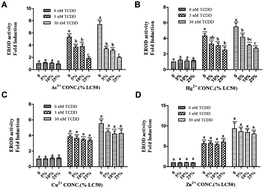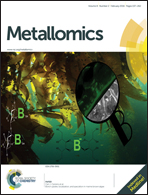Differential effects of metal ions on TCDD-induced cytotoxicity and cytochrome P4501A1 gene expression in a zebrafish liver (ZFL) cell-line†
Abstract
Trace metal ions and trace organic compounds are common co-contaminants in the environment that pose risks to human health. We evaluated the effects of four metal ions (As3+, Cu2+, Hg2+, and Zn2+) on 2,3,7,8-tetrachlorodibenzo-p-dioxin (TCDD) induced cytotoxicity and the expression of the cytochrome P4501A1 gene (cyp1a1) in the zebrafish liver (ZFL) cell line. A metal accumulation study showed that Cu and Zn did not accumulate in ZFL cells. However, As and Hg did accumulate, which resulted in the inhibition of TCDD-mediated induction of cyp1a1 mRNA and protein expression, and 7-ethoxyresorufin O-deethylase activity. A luciferase assay showed that both As3+ and Hg2+ inhibited the TCDD-induced activity of gene constructs containing either synthetic 3XRE or a distal cyp1a1 promoter region, implying that the decreased levels of TCDD-induced cyp1a1 were due to transcriptional effects. A proteomic study showed that the toxic effects of As3+ might be due to changes in cellular metabolic processes, the cellular stimulation response and the cellular redox state in ZFL cells.


 Please wait while we load your content...
Please wait while we load your content...